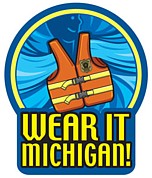Boating Safety Tutorials

There's some good information on the web that can help you become a better, safer boater. Below, you'll find descriptions for the tutorials located in the menu bar at left.
Towards the bottom of the page, you'll find a tutorial on the history and proper use of marine signal flares.
Please note that in using these links, you will be leaving the Flotilla 22-5 website and that the USCG Auxiliary makes no claims about the security, policy or standards of the linked sites.
- DSC/VHF Radio: A YouTube video produced by Florida State College in conjunction with the U.S. Coast Guard and the U.S. Coast Guard Auxiliary. This program on Digital Selective Channel radios includes a description of the Coast Guard's Rescue 21 system. (4:55)
- Inflatables Safety: Towing a tube? Tubing can be great fun, but there's a right way and a wrong way to do it. Inflatables Safety Video, produced by the Water Sports Industry Association, will teach you how to properly tow an inflatable. (5:45)
- Knot Tying: "Marlinspike seamanship" is the sailor's art of tying sailor's and splices. Back in the Age of Sail days, it was an essential part of a sailor's toolkit and took much of a sailor's time. Times have changed, but knowing how to properly tie knots is still essential knowledge for a boater. Tying a knot improperly or using the wrong knot for the job can result in your boat drifting away from its dock, or in a line parting at the wrong time.The Animated Knots website provides video instructions on the most common knots and splices used in boating, and which knot is best for the job.
- Marine Radios: Can You Hear Me? is a seven-part introduction to radio communications for the recreational mariner. The program is an includes information on both traditional VHF radios and the newer VHF/DSC radios. Can You Hear Me? was produced by the U.S. Coast Guard's Office of Boating Safety and the Boat/US Foundation.
Signal Flares
If you use your boat on navigable waters—waters that are a part of or connect to the Great Lakes or the ocean—Coast Guard regulations require that you carry signal flares.
Signal flares can save your life. Problem is, activating a flare in a non-emergency situation is against the law and can get you in big trouble. As a consequence, most boaters have little or no experience using the flares they are required to carry.
To solve this dilemma, the folks at Orion Safety Products put together a video presentation on how to select and use marine flares. This video is in three parts and is posted on YouTube. Clicking on the links below will take you to the videos. The complete series takes about 20 minutes to view.
Part 1 Introduction, history of marine signal flares, Coast Guard regulations, how flare height affects visibility (5:30)
Part 2 Types of flares, flare construction, when to use flares (7:13)
Part 3 How to use a flare, demonstrations (7:15)